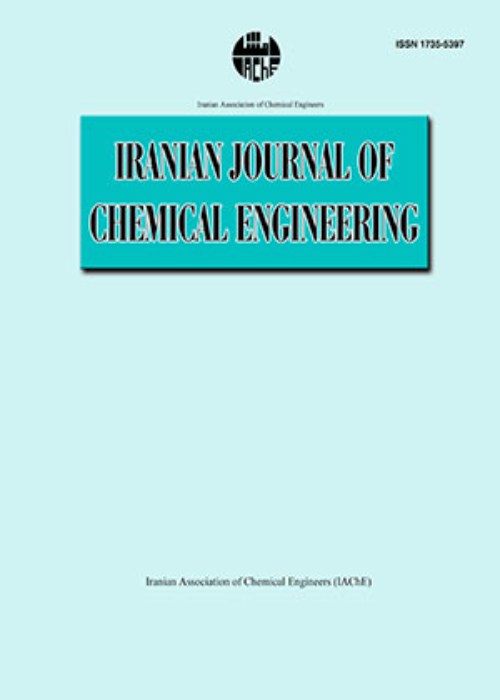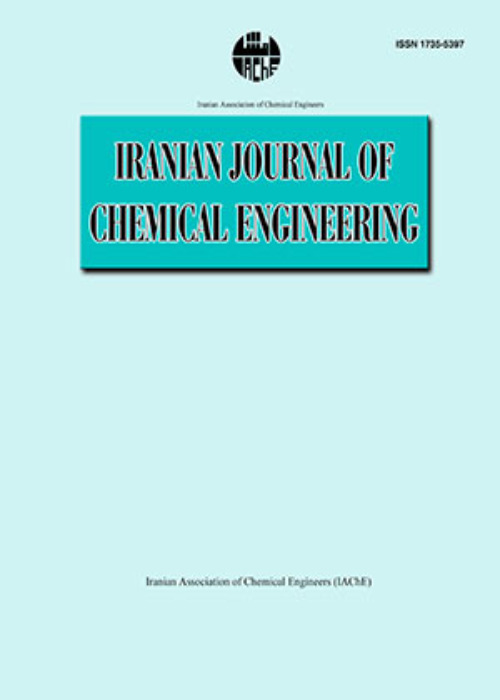فهرست مطالب

Iranian journal of chemical engineering
Volume:20 Issue: 1, Winter 2023
- تاریخ انتشار: 1402/05/18
- تعداد عناوین: 6
-
-
Pages 3-21
The purpose of this research is CFD modeling of the fluid flow inside an industrial valve in order to discover the areas with high shear stress and to determine the effect of hydrodynamic on the erosion rate. CFD results are compared with the existing experimental data in a valid reference and the model is verified with high accuracy. The impact of the pressure at inlet and the disc angle on the erosion is investigated. By increasing inlet pressure, maximum velocity, turbulence intensity, wall shear stress and particle erosion increased. However, the wall shear stress, turbulence intensity, and particle erosion are clearly reduced as the disc angle decreases. When the disc angle is less than 50o, the range of dependent parameters changes has a small value. Reducing the disc angle or increasing the inlet pressure led to an increase in cavitation. Therefore, to prevent the erosion of the butterfly valve, it is necessary to increase the disc angle or reduce the pressure at inlet. Erosion of the butterfly valve significantly occurred at the front and rear of the disc. Depending on the disc angle, the shear stress of wall for the modified configuration is 10 to 80 times lower than the original butterfly valve. Therefore, it can be stated that the modified geometry can reduce the wall shear stress and consequently the erosive for all the disc angles of the studied butterfly valve.
Keywords: Erosion, CFD, Butterfly Valve, Cavitation, Modeling -
Pages 22-35
In this paper, CFD modeling of ferrofluid convection heat transfer in a micromixer with static magnetic field (SMF) and rotating magnetic field (RMF) is investigated. Applying a magnetic field and the existence of magnetic nanoparticles lead to the creation of transverse vortices in the micromixers by movement of nanoparticles, that improves heat transfer. There is a cylindrical pit in the microcmixer with heat source that is applied to its bottom wall. Top wall of the pit is adjacent to a fixed permanent magnet, which creates the SMF. CFD modeling first is done for heat transfer process in the micromixer in the absence of the magnetic field. Secondly, simultaneous effect of the SMF and magnetic nanoparticles on the flow pattern and heat transfer rate of ferrofluid is evaluated. Results showed that ferrofluid leads to the improvement of the heat transfer rate compared to pure water. The secondary flows induced by nanoparticles’ motion toward SMF decreases the velocity in the area of application of the magnetic field, so the heat transfer coefficient decreases. But, in the case of RMF, applying the magnetic field causes the nanoparticles to rotate inside the pit, which leads to an increase in the heat transfer coefficient. CFD results of heat transfer coefficient are compared with experimental results in a reliable reference and acceptable agreement between them is observed.
Keywords: CFD modeling, Micromixer, Magnetic field, Heat Transfer Coefficient -
Pages 36-50
Drug delivery systems (DDSs) have become a crucial aspect of cancer therapy, and researchers are continuously striving to identify the optimal methods for targeted delivery and release of therapeutic agents. Metal-Organic Frameworks (MOFs) have emerged as a promising class of materials for DDSs due to their exceptional storage capacity, unique characteristics, and high durability. This comprehensive review explores the wide-ranging applications of MOFs in various fields, including catalysis, gas separation and storage, fuel purification, water treatment, medication administration, and imaging. The review paper evaluates different approaches to synthesize MOFs, such as self-assembly of metal ions and clusters and the solvothermal method, to optimize their performance characteristics.The present study aims to shed light on the numerous challenges associated with utilizing MOFs in clinical settings. However, MOF nanocomposites that incorporate reinforcement phases represents a promising strategy for addressing these issues. With the incidence of cancer on the rise, targeted MOFs offer a potential solution to the lack of selectivity of certain drugs by virtue of their distinctive physical and chemical properties. This investigation delves into how MOFs can be employed to regulate drug release in DDSs and presents research on key applications of MOFs in the realm of cancer therapy. The application of UiO-66 for drug delivery systems and explore the different physical characteristics and chemical structures of dicarboxylate ligands incorporated into UiO-66 topology MOFs were investigated. Overall, the review paper provides a comprehensive overview of the diverse applications of MOFs and their potential for drug delivery systems in cancer therapy.
Keywords: Metal-organic Frameworks, Drug delivery system, UiO-66, Cancer treatment, Nanoscale -
Pages 51-66
The Fe3O4/MW-CNT composite was prepared for a hybrid photo-catalyst-assisted electrochemical process for the removal of BTX contamination from wastewater. Oxidation of multi-walled carbon nanotube was conducted by different treatments including acid treatment and hydrogen peroxide. The XRD, FTIR, SEM, TEM, and BET analyses were performed to characterize both the MW-CNT and the synthesized composite. Simultaneous photo-catalyst and electrochemical processes were conducted to evaluate the performance of a new hybrid process for wastewater treatment. The effect of current density, photo-catalyst loading, and BTX initial concentration was investigated experimentally. The characterization results of the synthesized composite show that a mixture of strong nitric acid and sulfuric acid treatment at a high exposure time and low temperature is the best route for MW-CNT oxidation. The removal efficiency of BTX compounds from wastewater using the hybrid photo-electrochemical process was found to be in the range of 28 to 43% for different conditions. The optimum condition for maximum removal of BTX was found by mathematical modeling of experimental data. The results indicate that a combination of photo-catalyst and the electrochemical process can enhance the BTX removal efficiency.
Keywords: Multi-walled carbon nano-tube, Photo-catalyst, electrochemical, hydrothermal treatment, Fe3O4, MWCNT composite -
Pages 67-77
Polysulfone-zinc oxide mixed matrix membrane (MMM) was fabricated. A polyamide layer was formed on the top surface of the membranes using interfacial polymerization process. The properties and structure of the membranes were investigated and the membranes were used for desalination in reverse osmosis process. Cross-sectional images of the membranes substrate showed that the addition of zinc oxide to the polymer matrix resulted in a denser structure and increased the thickness of the sponge-like layer near the lower surface of the membrane. The addition of zinc oxide to the polymer matrix decreased the surface contact angle of the membrane with water, thereby increasing the hydrophilicity of the membrane. The pure water flux of all membranes reduced at the beginning of the process and after 60 min remained almost constant at the values of 19.50 (Lm-2h-1) and 30.20 (Lm-2h-1) for the membrane made with plain polymer and the MMM, respectively. In the reverse osmosis process, the water flux of the membrane fabricated using plain polymer was 9.70 (Lm-2h-1) which increased by 39% and reached to 13.50 (Lm-2h-1) by the addition of zinc oxide nanoparticles. The salt rejection of plain polysulfone membrane was 92.5% which increased to 97.21% with the addition of zinc oxide to the polymer matrix. The addition of zinc oxide nanoparticles to the polymer matrix significantly decreased the water permeability to salt permeability ratio (B/A) from 40.54 to 14.35 (kPa).
Keywords: Desalination, Reverse Osmosis, mixed matrix membrane, Thin film composite, Polyamide Layer, Zinc oxide nanoparticles -
Pages 78-91
Nisin is a natural heat resistance preserver with wide applications in food industries. The main drawback of nisin is its weak activity against most Gram-negative bacteria. In this study, the antibacterial activities of nisin against Salmonella typhimurium, Klebsiella pneumoniae, Citrobacter freundii, and Escherichia coli improved via the Maillard reaction with xanthan. The nisin-xanthan conjugates analyzed by the ultraviolet, fluorescence, and Fourier transform infrared spectroscopies. The results showed temperature, reaction duration, and nisin-to-xanthan ratio affected the quality of the obtained conjugates. In relevant to the results, the antibacterial activity of 100 mg L-1 of the conjugates was increased against S. aureus, S. typhimurium, and E. coli when the nisin to xanthan ratio was increased from 1:1 to 4:1 and reached 88.8, 98.7, and 97.7%, respectively. The increase in temperature from 90 ᵒC to 110 ᵒC enhanced the antibacterial effects against all test bacteria, especially for persistent Gram-negative cells, namely C. freundii and K. pneumoniae. The longer Maillard reaction after 110 min at 110 ᵒC did not improve the antibacterial activity of the conjugates against all test bacteria. The best antibacterial activity was observed at a temperature of 110 ᵒC for 110 min for a nisin-to-xanthan ratio of 4:1.
Keywords: Antibacterial peptide, Bacteriocin, Gram-negative bacterium, growth inhibition, Natural preservative


